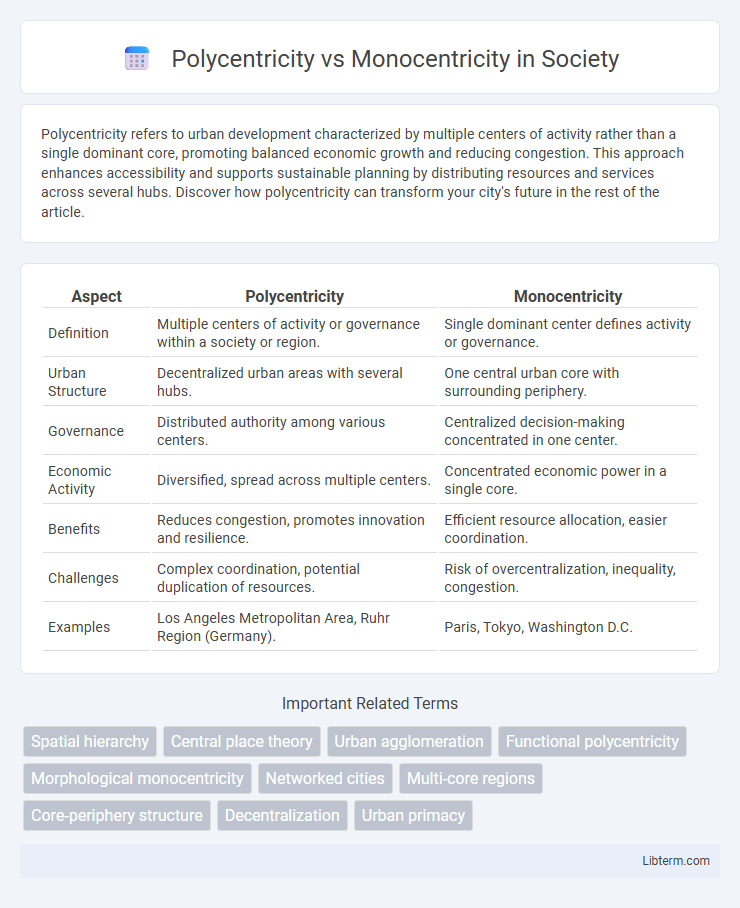Polycentricity refers to urban development characterized by multiple centers of activity rather than a single dominant core, promoting balanced economic growth and reducing congestion. This approach enhances accessibility and supports sustainable planning by distributing resources and services across several hubs. Discover how polycentricity can transform your city's future in the rest of the article.
Table of Comparison
| Aspect | Polycentricity | Monocentricity |
|---|---|---|
| Definition | Multiple centers of activity or governance within a society or region. | Single dominant center defines activity or governance. |
| Urban Structure | Decentralized urban areas with several hubs. | One central urban core with surrounding periphery. |
| Governance | Distributed authority among various centers. | Centralized decision-making concentrated in one center. |
| Economic Activity | Diversified, spread across multiple centers. | Concentrated economic power in a single core. |
| Benefits | Reduces congestion, promotes innovation and resilience. | Efficient resource allocation, easier coordination. |
| Challenges | Complex coordination, potential duplication of resources. | Risk of overcentralization, inequality, congestion. |
| Examples | Los Angeles Metropolitan Area, Ruhr Region (Germany). | Paris, Tokyo, Washington D.C. |
Introduction to Polycentricity and Monocentricity
Polycentricity refers to urban or regional structures characterized by multiple centers of activity or hubs, each serving as focal points for economic, social, and cultural functions, promoting balanced development and reducing congestion. Monocentricity, in contrast, describes a spatial organization dominated by a single core city or center that concentrates most services, employment, and infrastructure, often leading to challenges like urban sprawl and overburdened central areas. Understanding these models is crucial for urban planning and policy-making aimed at enhancing sustainability, connectivity, and quality of life in metropolitan regions.
Defining Monocentricity: Core Concepts
Monocentricity refers to an urban or regional structure where economic, social, and administrative activities are concentrated around a single central place or core. This core typically functions as the dominant hub for employment, services, and transportation, influencing the spatial organization and land use patterns within the metropolitan area. The monocentric model often leads to distinct urban gradients, with density and land values decreasing progressively from the center to the periphery.
Defining Polycentricity: Core Concepts
Polycentricity refers to an urban or regional structure characterized by multiple centers of economic, social, and cultural activities that are relatively independent yet interconnected. Each center in a polycentric system maintains its distinct identity and functionality, contributing to a balanced spatial development and reducing congestion in a single urban core. This decentralization contrasts with monocentricity, where a single dominant center governs the flow of resources and activities within the region.
Historical Evolution of Urban Structures
Polycentricity emerged as a response to the limitations of monocentric urban structures, characterized by a single dominant center, which dominated city planning until the Industrial Revolution. Historical urban evolution shows monocentric cities concentrated economic activities and population around a central business district, while polycentric development arose with increased transportation technologies and suburbanization, dispersing functions into multiple centers. Modern metropolitan regions increasingly exhibit polycentricity, fostering balanced regional growth, reducing congestion, and enhancing accessibility across distributed nodes.
Key Differences Between Polycentric and Monocentric Models
Polycentric models feature multiple centers of activity within a region, promoting decentralized economic growth and reducing congestion in urban areas, whereas monocentric models concentrate development around a single central business district, intensifying land use and transportation demand there. Polycentric urban forms support diverse employment hubs and facilitate shorter commutes by distributing services and amenities widely, while monocentric cities often face challenges related to overcrowding and longer travel times to the core. The spatial structure in polycentric systems encourages balanced regional development and resilience, contrasting with the hierarchical, centralized spatial dynamics characteristic of monocentric systems.
Advantages of Polycentric Urban Development
Polycentric urban development promotes balanced economic growth by distributing resources and services across multiple centers, reducing congestion and strain on infrastructure in a single core city. This spatial structure enhances regional connectivity and accessibility, fostering innovation hubs and diverse employment opportunities. Environmental sustainability benefits arise from shorter commutes and lower emissions, supporting resilient and adaptable urban systems.
Challenges of Monocentric Urban Systems
Monocentric urban systems often face significant challenges such as congestion, high infrastructure costs, and limited spatial resilience due to the concentration of economic activities and population in a single city center. This centralization typically results in excessive commuting times, increased pollution, and urban sprawl, which strain public transportation and housing availability. In contrast, polycentric urban systems distribute services and jobs across multiple centers, promoting more balanced regional development and reducing pressure on any one area.
Case Studies: Examples Around the World
Polycentric urban regions like the Randstad in the Netherlands exhibit multiple interconnected centers that distribute economic activities and reduce congestion compared to monocentric models such as Paris, where a single dominant core drives development. Case studies from the Ruhr Area in Germany demonstrate how polycentricity supports regional resilience by fostering collaboration among cities, contrasting with Tokyo's monocentric approach that centralizes infrastructure and services. These examples highlight diverse spatial strategies influencing urban sustainability, accessibility, and economic diversification worldwide.
Impacts on Sustainability and Urban Mobility
Polycentric urban structures enhance sustainability by distributing economic activities and reducing travel distances, which lowers carbon emissions and traffic congestion compared to monocentric cities. Polycentric cities promote diverse transit options and active transportation modes, improving urban mobility and decreasing reliance on private vehicles. In contrast, monocentric cities often face increased environmental pressure and mobility challenges due to centralized congestion and longer commuting distances.
Future Perspectives: Towards Balanced Urban Growth
Polycentricity promotes sustainable urban development by distributing economic activities and infrastructure across multiple centers, reducing congestion and fostering regional equity. Advances in smart city technologies and integrated transportation systems enable seamless connectivity between polycentric hubs, supporting balanced growth. Future urban planning increasingly favors polycentric models to enhance resilience, economic diversity, and environmental sustainability over monocentric concentration.
Polycentricity Infographic

 libterm.com
libterm.com